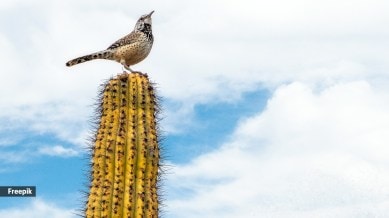📣 For more lifestyle news, click here to join our WhatsApp Channel and also follow us on Instagram
How the ‘cactus killer’ bird turns its own droppings into food
The bird essentially creates its own renewable food sources by depositing seeds that will mature into fruit-bearing plants.

In the arid landscapes of Chile, nature shows its remarkable ability to create symbiotic relationships. The Chilean mockingbird (Mimus thenca), nicknamed the ‘cactus killer,’ has evolved a cunning yet fascinating survival strategy that transforms its own waste into a future food source, with the help of — you guessed it — cacti.
This clever bird’s reputation stems from its role as an unwitting accomplice in one of nature’s most devious parasitic relationships. It feeds on the bright, sticky fruits of mistletoe plants, particularly species like Tristerix, which are holoparasites, organisms that derive all their nutrients from their host plants.
A unique parasitic relationship
After consuming these mistletoe fruits, the mockingbird’s digestive system works its magic. The bird digests the nutritious fruit flesh while the sticky mistletoe seeds remain intact, coated in mucilaginous material that helps them survive the journey through the bird’s digestive tract.
When nature calls, the mockingbird often perches atop cacti to relieve itself, unknowingly delivering these viable seeds directly onto their next victim. The genius of this system lies in these sticky droppings, which cling to the cactus surface and provide the perfect starting point for seeds to germinate, allowing the plant to establish itself through an efficient invasion strategy.
According to ResearchGate, “After eating the fruits, the bird often perches on the top of cacti and defecates the sticky mistletoe seeds that adhere to the surface or lateral spines of the new host. After some days, the seed has elongated a long radicle that eventually contacts the cactus epidermis to form a haustorial disk. The mistletoe cells enter the cactus tissue, tap the phloematic vessels, and the parasitic plant grows inside for 18 months, after which the reproductive portion of the parasite emerges from the cactus surface (sic).”
During the months that the parasitic plant grows inside, it penetrates the cactus’s outer layer to access its water and nutrient supply.
The long-term strategy
But, the mockingbird’s long-term strategy becomes apparent here: as the mistletoe establishes itself on the infected cactus through this nighttime infiltration, it produces more fruit. The bird essentially creates its own renewable food sources by depositing seeds that will mature into fruit-bearing plants. It’s a biological investment that pays dividends for generations of mockingbirds.
While devastating for individual cacti, this symbiotic relationship highlights how desert species have evolved remarkable strategies for survival, turning even waste products into valuable resources for the future.
📣 For more lifestyle news, click here to join our WhatsApp Channel and also follow us on Instagram